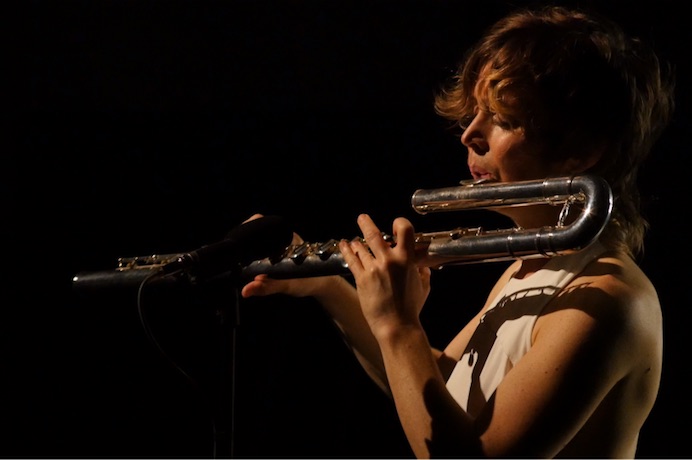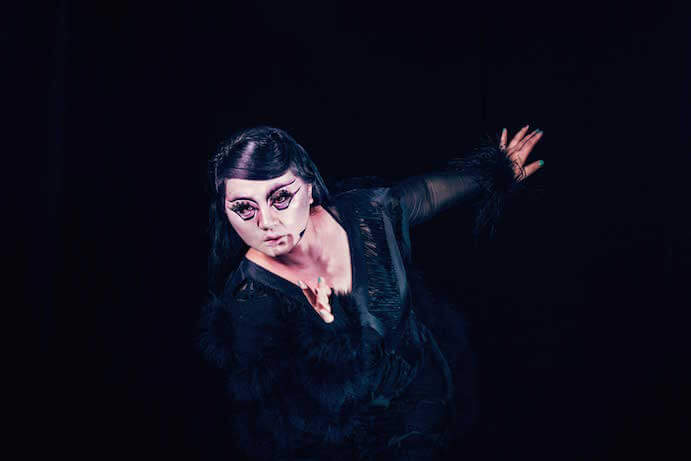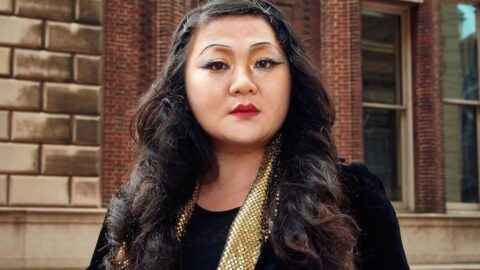The auditorium was still only half-full at 8 PM on November 15 as Du Yun’s loyal fans were making their way to Miller Theatre through blustery winds, slush, snow, and a particularly challenging evening for the MTA. Around ten minutes past the hour, Du Yun’s Composer Portrait concert began, seats filled by then with a damp, yet enthusiastic audience.
The first half of the program combined six of Du Yun’s works written over the span of nineteen years (1999-2018) into “LEGOs.” Du Yun and her colleagues fashioned these individual pieces into a visual and acoustic masterpiece, with each composition moving seamlessly into the next. Members of the International Contemporary Ensemble stood onstage together, with soloists coming to the forefront, and then fading into black when other players came forward. Without Lara Pellegrinelli’s excellent program notes, one might think that these works were originally conceived as a single composition. Rather, the ensemble came together to create a cohesive and magnificent new work that highlighted the beauty and collaborative nature of Du Yun’s compositional practice.
In LEGO 1, Claire Chase was utterly captivating as she navigated the lyrical passages, flutters, bold accents, hums, and sighs of An Empty Garlic–finale (2014). In this spellbinding performance, Chase’s bass flute became both a quasi-organ–embracing a vast sound world–and a seemingly inevitable extension of her breath. LEGO 2, comprised of Ixtab, 10pm (2013) and Dinosaur Scar (1999), featured the talents of bassoonist Rebekah Heller and saxophonist Ryan Muncy who embraced the works’ boundary-pushing feats of physicality while maintaining an active and engaging musical dialogue. Violinist David Bowlin’s commanded the stage in LEGO 3, playing the folk-like melodies of Under a tree, an udātta (2016) tenderly and punctuating them with jolting rhythmic interjections, the sounds fading and emerging like waves.

Du Yun lent her vocals and bowed tree trunk to LEGO 4, consisting of Zinc Oxide, a tale of a seagull (2010), alongside Katinka Kleijn, voice and cello. Du Yun and Kleijn were well-matched duo partners with Kleijn’s dulcet timbre a nice balance to Du Yun’s mezzo-hued voice. Finally, LEGO 5, (Air Glow, 2006/2018 for five brass instruments and electric guitar), revealed layers of repeated motives overlapping into intricate polyphonic sections, coming together, and then splitting apart again. Nicholas Houfek’s exquisite lighting design and Levy Lorenzo’s performance on electronics created a veritable connection between each individual work, and they were instrumental in the LEGO series’ success.
In the second half of the program, ICE, led by David Fulmer, offered Du Yun’s Impeccable Quake (2004) for chamber orchestra and Vicissitudes No. 1 (2002) for five players, including a steel-string guitar solo, performed brilliantly by Dan Lippel. While these early compositions were not programmatically connected to each other as were the LEGOs of the first half, they displayed many of the same characteristics: a propulsion of dense layers of sound punctuated by virtuosic solos which emerge and fade back into the texture of the ensemble. Under Fulmer’s confident direction, the ensemble gave a precise and balanced rendering of these dynamic works, and these selections were an energetic and powerful way to end the concert.

In between the two halves of the program, Du Yun sat for a brief but insightful onstage conversation. She discussed the great importance of vulnerability, trust, and—though she loathed to use the word—synergy between the composer and performers. Du Yun noted, “People are the most important factor in my life,” and it is clear that the personal element between composer (or composition) and performer is far from an afterthought in her music. Rather, it is very much the point. Du Yun became genuinely emotional when she described how she and her collaborators become each other’s sounding board, asking, “Is it good enough? Is it bad?” encouraging one another to continue to tell stories of ever-changing human relationships.
Du Yun also described her unique compositional style and her use of “maximalism” (the dense layering of textures and sonorites present in many of her works), and noted that despite being discouraged that her orchestrations were too thick, she resolved that, “If I can hear it, I’m going to write it, and maybe others will hear it as I do.” It is clear that Du Yun’s eclectic, flexible approach to composing, her drive to seek the personal and profound in her work, as well as her masterful prowess as a storyteller have made her one of the most compelling composers of our generation.
























